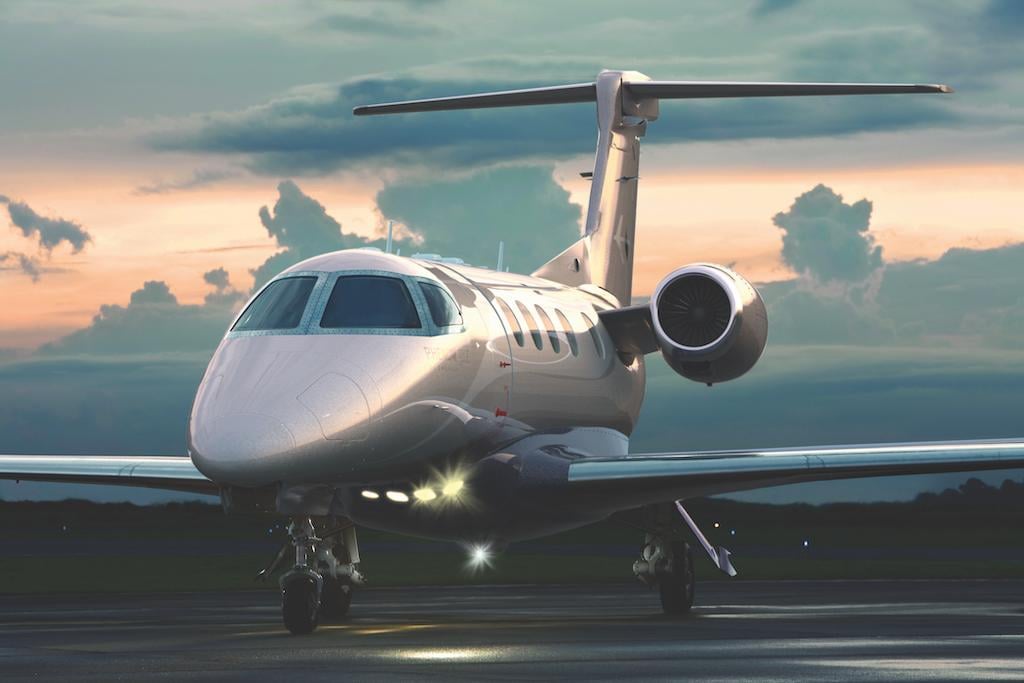
An Embraer Phenom 300
An Embraer Phenom 300 crew attempted to stop on a short, wet runway at Elk River Airport (NC06), North Carolina, in 2021.
That attempt failed, and the pilots very nearly went off a cliff and into a river. Why did that happen when their preflight planning showed they would be able to stop?
The ensuing NTSB investigation answered that question in detail.
While pilots are taught the factors that affect landing distance, they often do not know how much a tailwind, for example, will increase the distance. They do not know how much being high or fast on approach matters, nor how to judge the potential performance of the wheel brakes before they land. The Elk River incident pilots were off a bit in each of these parameters, and the discrepancies added up.
There are also certain assumptions built into preflight landing performance calculations that many pilots do not fully understand. Those assumptions proved faulty on the day of the incident.
The Phenom, registration N413N, departed Teterboro Airport (TEB), New Jersey, at midday on Aug. 26, 2021. The destination was NC06, a private airport in Banner Elk, North Carolina. It was being operated as a Part 91 positioning flight, and the two pilots were the only occupants. Neither pilot had been to NC06 before.
The town of Banner Elk describes itself as “a popular getaway in the Blue Ridge Mountains of the North Carolina High Country.” The airport’s website says it is “for the exclusive use of the Elk River Property Owners Association members and their approved guests.” No commercial or non-member flights are permitted. The runway is tucked into a narrow strip of land located between the mountains and the Elk River. Lush forest surrounds the airport, and tall trees line the right side of Runway 12.
Multiple Hazards Noted
The airport provides a six-page manual and instructional video on its website for the use of pilots thinking of landing there. The manual warns of multiple hazards, including occasional windshear, a precision approach path indicator (PAPI) with a glidepath greater than 4 deg., a last-moment turn needed to align with the runway and nearby mountains up to 1,500 ft. above the airport. The airport elevation is 3,468 ft MSL and the 4,605-ft.-long runway is only 75 ft. wide. There is no instrument approach.
The Phenom pilots read the airport manual and watched the video the night before the flight. They reviewed landing performance data for a dry and wet runway using runway analysis data provided by Aircraft Performance Group (APG). The results showed that, for landing with a wet runway, they could land at up to 17,042 lb. Their expected landing weight was only 15,210 lb.
The airplane lifted off at TEB at 1210 EDT. The co-pilot was flying. During cruise the pilots agreed that they would try only two approaches before diverting to an alternate. The pilot-in-command (PIC) planned to make the approach and landing. In his briefing, he said, “do what that video says,” and they “were good up to 10 kt., in and out.” At 1323, the crew spotted the valley where the airport was located and canceled instrument flight rules. When they contacted the Elk River CTAF, the operator told them there was no traffic, the wind was calm and it was raining.
According to the airport manual the pattern altitude for the approach is 5000 ft., and the end of the runway temporarily goes out of sight when on downwind. That is because there is a mountain between the path of the downwind leg and the airport. The base leg is unconventional, angling down through a mountain valley. A church and a cemetery were recommended cues as the airplane descended toward the runway.
On the downwind leg, the pilots discussed visible precipitation at or near the airport, and the PIC said, “we can land in the rain as long as it’s [visual flight rules].” As they flew down the valley, the PIC spotted the church. At 1334 he called the field in sight and inhibited the terrain warning. Flaps were full. After the electronic 500-ft. callout, the PIC said, “it looks like we’re on PAPI,” and the co-pilot agreed. The cockpit voice recorder picked up the sound of raindrops hitting the cockpit window, and that sound continued throughout the recording.
When the electronic voice called out “two hundred,” the PIC said, “all right, I’m going to dip it here,” and then “get down get down, come on baby get down.” As the airplane touched down, he said “on the brakes.” Twelve seconds later, he said, “stop, stop.”
The PIC applied full brakes once the jet touched down on the runway, but there was no apparent braking. The Phenom veered to the right, and the right main gear went off the edge of the runway. To correct, the PIC applied full left rudder to steer the jet back to the left and it entered a skid.
The Phenom crossed over a taxiway and across a grassy area, struck a sign with its left wing and came to a stop after striking a parked car. The nose of the jet was about 20 ft. from a steep cliff that descended sharply to the Elk River. The pilots shut down the engines and evacuated through the main cabin door.
Recorded data later showed that for a 9-sec. period, both brake pressures dropped to around 1,000 psi as the anti-skid system sensed a skid.
“We hit a beige Jeep on our wingtip which actually caused us to stop and saved our lives by not allowing us to go off the cliff 5 ft. in front of us,” the captain later said.
Both pilots walked back to the runway. The captain described it as having no standing water, but after walking on the surface, he said he would “never expect a runway to be that slick.”
Multiple parties take part in the investigation of the runway excursion, in part two of this article.





